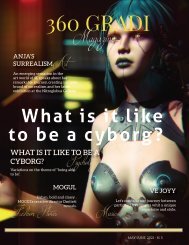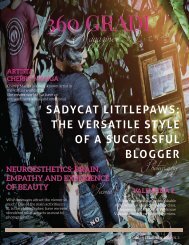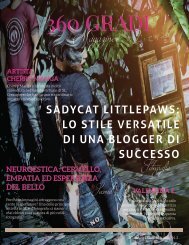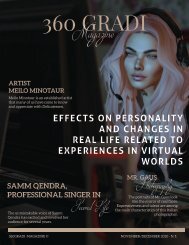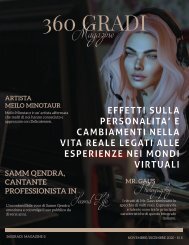360 GRADI MAGAZINE // March-April 2021
360 GRADI Magazine is the trendy, elegant, refined, and sophisticated publishing about Second Life (the virtual world by Linden Lab). Out every two months.
360 GRADI Magazine is the trendy, elegant, refined, and sophisticated publishing about Second Life (the virtual world by Linden Lab).
Out every two months.
Create successful ePaper yourself
Turn your PDF publications into a flip-book with our unique Google optimized e-Paper software.
I have through the senses with the world<br />
is certainly an altered relationship; he<br />
will later solve the problem of knowledge<br />
in other ways, but Descartes is not<br />
the main topic of this article.<br />
If we observe the<br />
image of a rainbow,<br />
intended<br />
as a perceptual<br />
experience of<br />
color, this forces<br />
us to declare that reality is not as it<br />
appears to us for the good reason that<br />
colors do not exist in the physical world.<br />
For example, the<br />
green of a plant is<br />
not a physical property<br />
of the plant,<br />
as is the weight<br />
and chemical nature<br />
based on the<br />
cellulose or the<br />
shape of its leaves;<br />
the green color of<br />
the plant is not in<br />
the plant, but is in the posterior part of<br />
the brain which is called the occipital<br />
lobe where the visual area is located. In<br />
humans, vision is the most developed<br />
sense, in fact most of the brain areas are<br />
involved in the recognition and coding<br />
of visual stimuli. Visual stimuli are collected<br />
from areas of the occipital cortex<br />
based on different characteristics. The<br />
visual stimuli come from the retinas of<br />
the two eyes, where the visual receptors<br />
are located, and are transmitted<br />
by each optic nerve to the brain, where<br />
they are transformed into moving<br />
images, multicolored, recognizable and<br />
recalled by memory. The visual area is<br />
organized in such a way that there are<br />
five layers of neurons, one superimposed<br />
on the other and these sheets<br />
perform different functions of visual<br />
perception. All the information coming<br />
from the retina arrives upside down in<br />
the V1 area, the image is broken down<br />
according to its characteristics and these<br />
parts are processed in the relevant<br />
areas of the visual cortex. Subsequently,<br />
the image is reconstructed in the prefrontal<br />
cortex, which will allow us to<br />
see it straightened and in color. come<br />
The V1 area is highly specialized in the<br />
processing of information regarding<br />
the shape and placement of static or<br />
moving objects in the visual field. Cells<br />
in V2 also respond to various complex<br />
characteristics, such as the orientation<br />
of illusory contours and binocular disparity.<br />
The V3 is responsible for the<br />
perception of the shape of moving<br />
objects. Area V5 is essential for processing<br />
information relating to movement.<br />
What interests us is the fourth of<br />
these overlapping sheets which is the<br />
one that processes the colors. In other<br />
words, the color phenomenon does not<br />
reside in nature but appears in this plate,<br />
which we have said to be the fourth<br />
and which we call V4; so, this is where<br />
the color phenomenon is born but not<br />
the color experience that we will examine<br />
later. We realize that, when we<br />
talk about the fact that colors are not a<br />
reality of the world but a production<br />
of our brain, the repercussions in the<br />
artistic field and especially in that of<br />
the visual arts are obviously important.<br />
If you look at the<br />
left image for the<br />
first time, most of<br />
you will not be able<br />
to understand what<br />
it is, but if you later look at the image<br />
on the right almost everyone will be<br />
26 <strong>360</strong> <strong>GRADI</strong>




